
Ticks are parasitic arachnids that are part of the mite superorder Parasitiformes. Adult ticks are approximately 3 to 5 mm in length depending on age, sex, species, and "fullness". Ticks are external parasites, living by feeding on the blood of mammals, birds, and sometimes reptiles and amphibians. The timing of the origin of ticks is uncertain, though the oldest known tick fossils are from the Cretaceous period, around 100 million years old. Ticks are widely distributed around the world, especially in warm, humid climates.

A scute or scutum is a bony external plate or scale overlaid with horn, as on the shell of a turtle, the skin of crocodilians, and the feet of birds. The term is also used to describe the anterior portion of the mesonotum in insects as well as some arachnids.
The Kadam virus is a tick-borne Flavivirus.

Nuttalliella namaqua is a tick found in southern Africa from Tanzania to Namibia and South Africa, which is placed in its own family, Nuttalliellidae. It can be distinguished from ixodid ticks and argasid ticks by a combination of characteristics including the position of the stigmata, lack of setae, strongly corrugated integument, and form of the fenestrated plates. It is the most basal lineage of ticks.

Amblyomma is a genus of hard ticks. Some are disease vectors, for example the Rocky Mountain spotted fever in Brazil or ehrlichiosis in the United States.
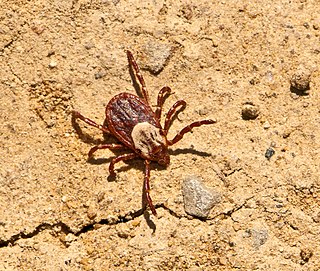
Dermacentor is a genus of ticks in the family Ixodidae, the hard ticks. The genus has a cosmopolitan distribution, with native species on all continents except Australia. Most are found in North America.
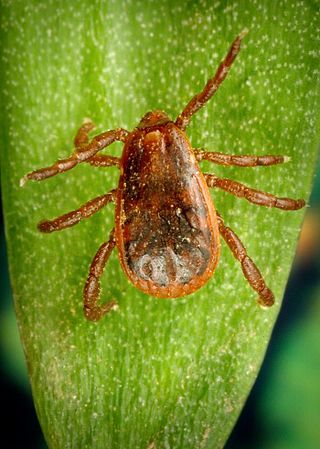
Rhipicephalus is a genus of ticks in the family Ixodidae, the hard ticks, consisting of about 74 or 75 species. Most are native to tropical Africa.
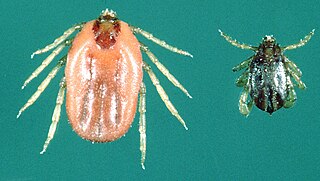
The Asian blue tick is an economically important tick that parasitises a variety of livestock species especially cattle, on which it is the most economically significant ectoparasite in the world. It is known as the Australian cattle tick, southern cattle tick, Cuban tick, Madagascar blue tick, and Puerto Rican Texas fever tick.

Ixodes hexagonus, also known by the common name hedgehog tick, is a tick species in the genus Ixodes. It is a parasite of the European hedgehog.
Rhipicephalus hoogstraali is a tick found in Djibouti and Somalia. First recognized by Harry Hoogstraal as Rhipicephalus longicoxatus based on an incomplete published description, after discovery of the holotype of R. longicoxatus, it was described and named to honor Hoogstraal in 2009.

Ixodes neuquenensis is a species of tick that lives on the monito del monte, a nocturnal marsupial that lives in the temperate forests of southern South America. Due to the near-threatened status of its host, Ixodes neuquenensis is also at risk.

Hyalomma dromedarii is a species of hard-bodied ticks belonging to the family Ixodidae.
Amblyomma albolimbatum is a species of tick. It is also known as the stumptailed lizard tick. It feeds on lizards, in particular skinks, but also snakes. It is endemic to Australia.
Amblyomma gervaisi is a hard-bodied tick of the genus Amblyomma. The tick is a parasite of snakes, such as Naja naja, Python molurus species and monitor species such as Varanus ocellatus, Varanus yemenensis, Varanus benghalensis, Varanus griseus and many other Varanus species in southeastern Asia and Asia-minor. They exhibit sexual dimorphism. They can be found in Sri Lanka, India, Yemen, Saudi Arabia. It is a potential vector for Coxiella burnetii.
Haemaphysalis bispinosa is a hard-bodied tick of the genus Haemaphysalis. It is found in India, Sri Lanka, Myanmar, Pakistan, Nepal, Australia, and Indonesia. It is an obligate ectoparasite of mammals. It is a potential vector of Kyasanur Forest disease virus. These ticks was found parasitized by a chalcid Hunterellus sagarensis in these diseased areas.
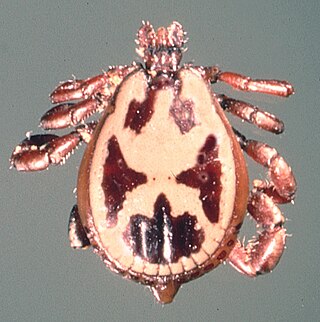
The zebra tick or yellow back tick is a species of hard tick. It is common in the Horn of Africa, with a habitat of the Rift Valley and eastward. It feeds upon a wide variety of species, including livestock, wild mammals, and humans, and can be a vector for various pathogens. The adult male has a distinctive black and ivory ornamentation on its scutum.
Ixodes siamensis is an ixodid tick that is parasitic on mammals in Thailand.
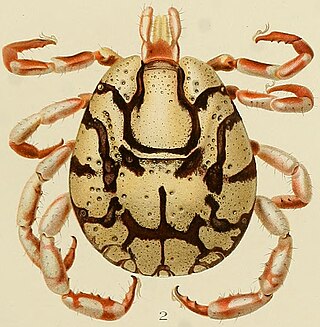
Cosmiomma is a genus of ticks first discovered by Paul Schulze in 1919. It is monospecific, being represented by the single species Cosmiomma hippopotamensis. It was first described in 1843 by Henry Denny from specimens collected from a hippopotamus in Southern Africa, and has been called "one of the most unusual, beautiful, and rare tick species known to the world."

Natalia Aleksandrovna Filippova was a world authority on the taxonomy of mites and especially ticks. Her monographs on the identification, morphology, development, distribution and behaviour of the family Argasidae and the sub-families of Ixodinae and Amblyomminae are standard works on these important vectors of disease.












